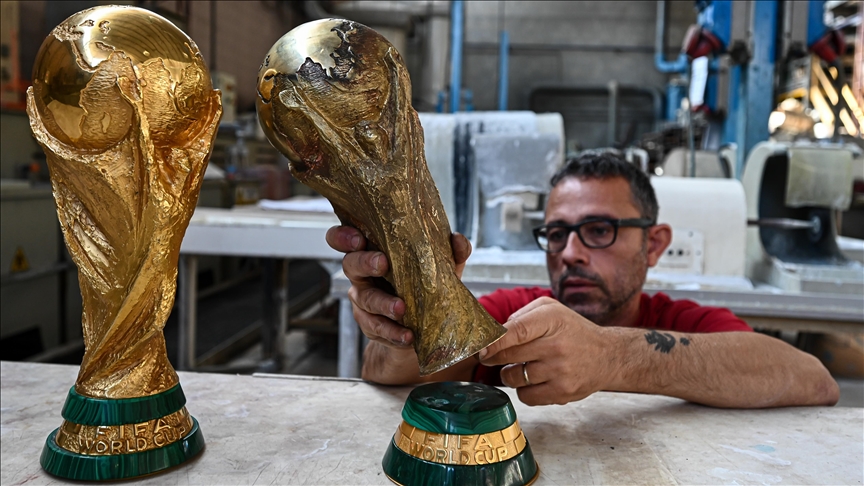

By Anadolu Agency
MILAN, Italy
GDE Bertoni headquarters is a small building situated in the industrial area of Paderno Dugnano, a town on the outskirts of Milan, northern Italy.
It has two floors of offices and workshops and a dozen employees. The company is one of the tens of thousands of small and medium enterprises that make up the backbone of the Italian economy and contribute to making it one of the most prosperous in the world.
But it is here that one of the most iconic objects on the planet has been produced for the past 50 years: the World Cup trophy.
In the early 1970s, in the aftermath of Brazil’s third Jules Rimet Cup victory in Mexico City against Italy, the story of the most famous cup began here.
According to the FIFA regulations at the time, the three victories in 1958, 1962, and 1970 meant that the Rimet trophy was to be taken home by the Brazilians without returning it to the headquarters of the World Football Federation in Zurich, as normally would happen.
It was at that moment that FIFA recognized the need to design and produce a new cup and launched an international competition in which 53 works from all around the world were submitted.
Among them was one designed by Milanese sculptor Silvio Gazzaniga, Bertoni’s artistic director, who is still highly regarded today, six years after his death.
“The idea of this cup came from him and my grandfather Eugenio Losa,” said Valentina Losa, the CEO of Bertoni, a fourth-generation family company founded in the early 1900s.
“Initially, the design depicted two goalkeepers raising hands and holding a football over their heads. After various discussions, the sketch of the sculpture was changed, and the two goalkeepers were replaced by two angels of victory. And instead of the ball, a globe was drawn.”
Gazzaniga and Bertoni’s work was selected and the West German national team was the first team awarded the sculpture at the 1974 World Cup.
Inside the workshop, workers care for the production of the cup. First, it is hammered, ground, and polished. Then, passing from the hands of one worker to another, it is washed with baking soda and immersed in various liquid solutions.
Finally, it is varnished. Standing 38 centimeters (15 inches) high, the cup weighs 6.2 kilograms (14 pounds).
“There’s only one existing original copy of the World Cup that remains with FIFA. It goes to the winning team during the award ceremony after the world final. It is made of 18-carat gold and is given back to FIFA, which sends it back to us to engrave the name of the winning team on the disc underneath, immediately after the award ceremony,” said Losa. “The winning team still gets a replica of the cup, not in gold but in golden brass, on which its name is engraved.”
The 2022 World Cup is already in Qatar, along with its replica, ready to be given to the team that wins the tournament at the end of a month of matches on Dec. 18.
But at Bertoni, which among other things also produces the UEFA Cup, the UEFA Super Cup, and the Champions League Trophy — the one with the big ears — workers are already working on the production of the trophy for the 2026 World Cup, which will be jointly hosted by Canada, the US, and Mexico. The golden ring at the base of the cup between green malachite discs bears the inscription: “FIFA World Cup 2026.”
“We will present it shortly when this World Cup is over,” said Losa.
We use cookies on our website to give you a better experience, improve performance, and for analytics. For more information, please see our Cookie Policy By clicking “Accept” you agree to our use of cookies.
Read More